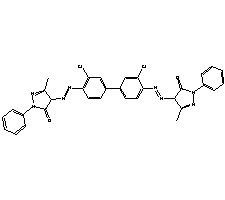Pigment Pomarańczowy 13
| Nazwa produktu | PIGMENT ORANGE 13 |
| Synonimy | C.I.Pigment Orange 13; C.I.PO13; PO13; P.O.13 |
| CI | 21110 |
| Nr CAS | 3520-72-7 |
| EINECS | 222-530-3 |
| Waga molekularna | 623.49 |
| Formuła molekularna | C32H24Cl2N8O2 |
| Gęstość | 1.42g/cm3 |
| Kolor | Pomarańczowy proszek |
![]()
Wzór struktury molekularnej:

Fastness Properties of Pigment Orange 13:
| Odporność na światło | 3-4 |
| Odporność na ciepło (℃) | 180 |
| Wodoodporność | 4-5 |
| Odporność na olej | 5 |
| Odporność na kwas | 4-5 |
| Odporność na alkalia | 4-5 |
| Odporność na alkohol | 3-4 |
Główne zastosowanie: Atrament na bazie wody, Atrament offsetowy, Atrament na bazie rozpuszczalnika, Plastik, Farba, Druk tekstylny
We have various pigment grades and properties to meet different customers’ needs, please specify your application and requirements so that we can recommend accordingly. E-mail: sy@sypigment.com
Product Description of Pigment Orange 13:
Pigmnet Orange 13 is used for coloring of ink, plastic, rubber, pigment printing paste and cultural and educational supplies; the shade is similar to that of Pigment Pomarańczowy 34, and the translucent specific surface area is 35-40m2/g (Irgalite Orange D specific surface area is 39m2/g); plastic PVC coloring is not recommended due to migration; Natural rubber is resistant to vulcanization and migration, so it is suitable for rubber coloring; detergent resistant, good water resistance, used for swimming articles, sponge, viscose fiber pulp, packaging ink and metal decorative paint coloring, heat resistance (200 ℃); and for rubber industry.
Pigment Orange 13 is an organic compound and an azo compound. It is a commercial orange pigment. It is also classified as a diarylide pigment, being derived from 3,3'-dichlorobenzidine. It is closely related to Pigment Orange 3, wherein the two phenyl groups are replaced by p-tolyl groups.
Pigment Orange 13 is coloristically very similar to Pigment Orange 34, but generally somewhat more yellow. Application of Pigment Orange 13 in polyolefins is limited. The pigment is very fast to detergents. It is also employed in viscous spin dyeing and in mass dyeing. The graphics industry, on the other hand, uses pigment orange 13 to an appreciable extent for packaging printing inks. Its fastness to light is average but the stability of pigmented prints to a number of organic solvents is excellent or almost perfect. Similarly, the prints are fast to paraffin, butter, and soap. They withstand heat very well and are stable up to 200°C. Pigment orange 13 thus lends itself to metal decor printing, provided its light-fastness suits the purpose. Likewise, its resistance to clear lacquer coatings and to sterilization is excellent.
TDS (Pigment Orange 13) MSDS (Pigment Orange 13)Synonimy
- Pigment Pomarańczowy 13
- 4,4′-((3,3′-Dichloro-[1,1′-biphenyl]-4,4′-diyl)bis(diazene-2,1-diyl))bis(3-methyl-1-phenyl-1H-pyrazol-5(4H)-one)
- SCHEMBL2641824
- AKOS025311122
- AKOS030627473
- Pigment Orange 13; 4,4′-[(3,3′-Dichloro[1,1′-biphenyl]-4,4′-diyl)bis(azo)]bis[2,4-dihydro-5-methyl-2-phenyl-3H-pyrazol-3-one]
- C.I.21110
- P0596
- H10760
- W-109143
Nazwa IUPAC: 4-[[2-chloro-4-[3-chloro-4-[(3-methyl-5-oxo-1-phenyl-4H-pyrazol-4-yl)diazenyl]phenyl]phenyl]diazenyl]-5-methyl-2-phenyl-4H-pyrazol-3-one
InChI: InChI=1S/C32H24Cl2N8O2/c1-19-29(31(43)41(39-19)23-9-5-3-6-10-23)37-35-27-15-13-21(17-25(27)33)22-14-16-28(26(34)18-22)36-38-30-20(2)40-42(32(30)44)24-11-7-4-8-12-24/h3-18,29-30H,1-2H3
InChKlucz: HKYYDLYCGBDWSB-UHFFFAOYSA-N
Kanoniczne UŚMIECH: CC1=NN(C(=O)C1N=NC2=C(C=C(C=C2)C3=CC(=C(C=C3)N=NC4C(=NN(C4=O)C5=CC=CC=C5)C)Cl)Cl)C6=CC=CC=C6
| Nazwa właściwości | Wartość nieruchomości |
| Waga molekularna | 623.5 |
| XLogP3-AA | 7.6 |
| Liczba dawców wiązania wodorowego | 0 |
| Liczba akceptorów wiązania wodorowego | 8 |
| Obrotowa liczba obligacji | 7 |
| Dokładna masa | 622.1399274 |
| Masa monoizotopowa | 622.1399274 |
| Topologiczna powierzchnia polarna | 115 Ų |
| Liczba ciężkich atomów | 44 |
| Formalna opłata | 0 |
| Złożoność | 1090 |
| Liczba atomów izotopu | 0 |
| Zdefiniowana liczba stereocentrum atomów | 0 |
| Niezdefiniowana liczba stereocentrum atomów | 2 |
| Zdefiniowana liczba stereocentrów wiązania | 0 |
| Niezdefiniowana liczba stereocentrów wiązania | 0 |
| Liczba jednostek wiązanych kowalencyjnie | 1 |
| Związek jest kanonizowany | TAk |






